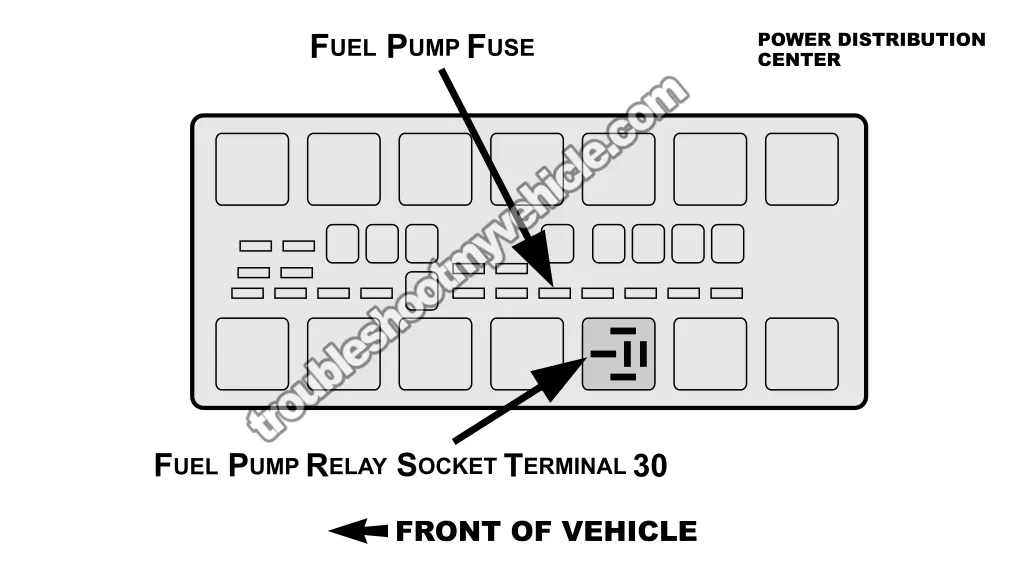
If your minivan won't start or runs rough and lacks power, a bad fuel pump might be the reason.
The cool thing is, we can find out without guessing or throwing parts at it —just by running a simple fuel pressure test.
In this tutorial, I'll walk you through how to test the fuel pump using a fuel pressure gauge —with easy to follow step-by-step instruction.
I'll also show you how to do a Starting Fluid Test to quickly check if the engine's getting any fuel at all.
Whether your engine cranks but won't fire up, or it runs poorly, this guide will help you figure out if a failing fuel pump is to blame.
Contents of this tutorial:
- Symptoms Of A Bad Fuel Pump.
- Where To Buy A Fuel Pressure Test Gauge.
- Fuel Pressure Specifications.
- TEST 1: Checking Fuel Pressure With A Fuel Pressure Gauge.
- TEST 2: Using Starting Fluid To Diagnose A No-Start Condition.
- Inspecting the Fuel Pump Fuse.
- More 3.0L V6 Dodge And Plymouth Minivan Tutorials.
APPLIES TO: This tutorial applies to the following vehicles:
- 3.0L V6 Dodge Caravan: 2000.
- 3.0L V6 Dodge Grand Caravan: 2000.
- 3.0L V6 Plymouth Voyager: 2000.
- 3.0L V6 Plymouth Grand Voyager: 2000.
ENGINE NO-START DIAGNOSTICS:
FUEL PUMP TEST TUTORIALS:
- How To Test The Fuel Pump (1994-1995 3.0L V6 Dodge And Plymouth Minivan).
- How To Test The Fuel Pump (1996-1999 3.0L V6 Dodge And Plymouth Minivan).
Symptoms Of A Bad Fuel Pump
The fuel pump's job is to deliver pressurized fuel from the tank to the engine. When the pump starts fails, it'll usually fail in one of two ways:
- Total failure: The fuel pump stops working and your engine won't start at all.
- Partial failure: The fuel pump still works and it even lets the engine start and idle. But as soon as you place a load on the engine, it stumbles or stalls.
That "load" is any operating condition where the engine demands more fuel than usual. A dying pump can't keep up with that demand, which leaves you with symptoms like:
- Rough idle: The engine may feel jumpy or unstable when parked.
- Extended engine cranking: You've got to crank the engine a lot before it finally starts —or doesn't start at all.
- No power: Engine feels weak when you press the gas pedal —sluggish throttle response.
- Backfires: Engine backfires out of the intake when accelerating —a classic lean mixture sign.
- DTC P0171: Check engine light is on with code P0171 —system running too lean.
Where To Buy A Fuel Pressure Test Gauge
The 2000 3.0L V6 engine doesn't have a Schrader valve to check fuel pressure.
The only way to do it is with a "double-ended barbed hose adapter". It's a small inline fitting that lets you tap into the fuel line between the supply hose and the fuel injector rail inlet line.
Below are fuel pressure test kits that come with the this adapter to get the test done safely and accurately.
Disclosure: As an Amazon Associate, I earn from qualifying purchases. If my tutorials help you, using these links is an easy way to support the site at no extra cost to you. Thank you!
Fuel Pressure Specifications
| 2000 3.0L V6 Fuel Pressure Spec | ||
|---|---|---|
| Year | KOEO | KOER |
| 2000 | 43-53 PSI | Not Given |
- KOEO = Key On Engine Off.
- KOER = Key On Engine Running.
TEST 1: Checking Fuel Pressure With A Fuel Pressure Gauge
If you've got a scan tool that can activate the fuel pump, that's your best bet —easy, accurate, and fast.
But if you're working without one, you're not out of luck since it's possible to activate the fuel pump without it.
You can trigger the fuel pump by bypassing the fuel pump relay with a jumper wire, and it only takes a few seconds.
IMPORTANT: Be careful with the jumper wire size —if it's too thick, it can deform the fuse box terminals where the relay plugs in, turning a simple test into a bigger electrical headache.
Let's get this show on the road:
- 1
Place a shop towel under the fuel line where it meets the injector rail to catch any accidental spills.
- 2
Disconnect the rubber fuel hose from the fuel injector rail's inlet pipe.
- 3
Connect the double-ended barbed hose adapter using the short rubber hose to the fuel rail inlet and tighten its hose clamp.
- 4
Reconnect the rubber fuel supply hose to the open end of the adapter and secure it with its clamp.
- 5
Now attach your fuel pressure gauge to the test port on the adapter.
- 6
Find the fuel pump relay in the underhood fuse box and pull it out.
- 7
Use a jumper to connect terminals 30 and 87 to turn on the pump manually.
NOTE: This will immediately and directly power up the fuel pump.
Check all your hose connections for leaks. If you see fuel leaking, remove the jumper wire, and go back and tighten things up. - 8
Your pressure gauge should read 43-53 PSI with the system pressurized.
Let's figure out what your fuel pressure test result is telling you:
CASE 1: Gauge shows proper pressure (43-53 PSI). Good news —your pump works.
If you're still chasing performance problems or an engine no-start issue, the fuel delivery system isn't the issue.
CASE 2: Pressure is weak and below spec. That confirms the pump is worn out and failing. It's not keeping up —you'll need to replace it.
CASE 3: Zero pressure, needle doesn't move. This generally tells you you've got a dead pump.
We still need to check and confirm power (12 Volts) at terminal 30 of the relay socket. If that checks out, the pump is toast. Go to: Checking The Fuel Pump Fuse.
TEST 2: Using Starting Fluid To Diagnose A No-Start Condition

This is one of the fastest ways to figure out if your engine's not starting because of a fuel delivery issue. It's simple and doesn't require any tools other than a can of starting fluid or carb cleaner (brake cleaner will work too).
If the engine fires up for a second when you give it that temporary fuel source, you'll know it's missing fuel —not spark or compression.
But I want to point out that this test only works if all six spark plug wires are actually firing spark, so double-check that first.
Once you've confirmed you've got spark, this test can point your engine no-start diagnostic in the right direction.
IMPORTANT: The accuracy of this test depends on all six spark plug wires firing spark. So before you reach for the carb cleaner or starting fluid, confirm that all six cylinders are getting spark. TEST 1 of this tutorial explains how to do that:
Alright, let's get going:
- 1
Disconnect the intake tube at the throttle body.
Pull the duct off just enough to expose the throttle plate. - 2
Open the throttle plate and spray a good shot of stating fluid into the throttle body bore.
- 3
Reattach the air duct quickly.
You don't need to secure it tightly —just make sure it's in place. - 4
Have a helper crank the engine as soon as the duct is reconnected.
- 5
The engine will do one of two things:
1.) It'll start, run and stall after a few seconds.
2.) The engine doesn't start.
Here's how to read what the engine just told you:
CASE 1: Engine ran briefly after the spray, then shut off. That tells you the engine has spark and compression —it's just starving for fuel.
Most likely, the fuel pump isn't working. You'll want to run TEST 1 next to measure fuel pressure and confirm: TEST 1: Checking Fuel Pressure With A Fuel Pressure Gauge.
CASE 2: No response at all when cranking. If the engine doesn't catch, even with the added fuel (starting fluid), the problem is probably not the fuel system.
Whatever's causing the engine to not start could be due to a deeper mechanical issue or a sensor issue.
Inspecting the Fuel Pump Fuse

Zero fuel pressure generally means the fuel pump is bad —but it's still super important to check that it's getting 10 to 12 Volts.
The power supply for the fuel pump comes from terminal 30 in the relay socket, which should show battery voltage at all times.
This power is supplied by fuse #5 (20 amp), which is also located in the Power Distribution Center. It doesn't matter if the ignition key is on or off —both fuse #5 and terminal 30 are "always HOT".
Grab your test light or multimeter and check for voltage at terminal 30. If nothing shows, pull fuse #5 and examine it.
If it's blown, swap it with a new one. Just remember, a blown fuel pump fuse is usually the result of a failing pump —one that's pulling too much current due to internal wear and tear.
If your new fuse pops again, you've got your answer —the fuel pump has to much internal wear and needs to be replaced.
If the fuse is OK and voltage is present at terminal 30 but your gauge still reads zero, the pump is getting power but isn't working. That confirms it's time to replace the fuel pump.
More 3.0L V6 Dodge And Plymouth Minivan Tutorials
You can find a complete list of 3.0L V6 Dodge and Plymouth minivan tutorials in this index:
Here's a small sample of the tutorials you'll find in the index:
- How To Test For A Broken Timing Belt (1988-2000 3.0L SOHC Chrysler).
- How To Replace The Distributor (1988-2000 3.0L V6 Chrysler, Dodge, Plymouth).
- How To Test Engine Compression (1987-2000 3.0L V6 Chrysler, Dodge, Plymouth).
- How To Test For A Blown Head Gasket (1991-2000 3.0L Caravan, Grand Caravan, Voyager, Grand Voyager).

If this info saved the day, buy me a beer!





